Lotus scoparius, also known as Deerweed or California Broom, is a short-lived perennial member of the legume family (Fabaceae), and native to much of California.
Growing at elevations below 5000 feet this wild-looking sub-shrub has an open, and airy informal habit.
Deerweed is frequently found in coastal sage and interior sage scrub, and common in recently disturbed soils. It is one of the first, and most prominent, native California plant species to re-emerge after wildland fires, where it serves to enrich post-fire nutrient devoid soils with nitrogen.
Before living here, we likely wouldn’t have given this plant a second look. However, there are at least a dozen large specimens of Lotus scoparius that have volunteered on the farm in the last couple of years, since we cleared the diseased and invasive plants, growing on the south slope by the orchard and gardens.

These plants emerged along the edge of the pathway that runs between the two sections of deer fence above the garden
Deerweed blooms in the early summer in our area along the coast, and is a welcome sight as many of our early spring wildflowers fade. The tiny flowers emerge a vivid shade of yellow, opening from the base of the stem toward the tip.
Once successfully pollinated the flowers turn an orange-red, which is less attractive to bee pollinators (bees see red as black), encouraging them to target the blooms that have not yet been visited.
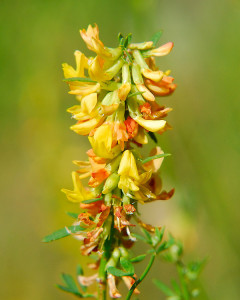
The orange colored flowers have been pollinated, and the bees will preferentially visit the remaining, unpollinated, yellow blossoms
As we’ve allowed these plants to establish themselves around the edges of the garden, we now have a few large groupings of Deerweed spilling down the bank near the bee hives.
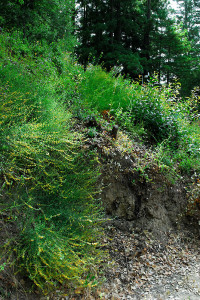
Deerweed usually grows upright, but will also spill downward over steep slopes, as shown here along this road-cut
Here they keep company with native sticky monkeyflower, hedge nettle, and cudweed.
This morning this bank was a-buzz with both native and honey bees busily working blooms.
In previous years we’ve appreciated seeing the flowers, but now that we have hives of honey bees on the farm, we’ve discovered that honey bees favor Lotus scoparius blossoms for their nectar over most other plants currently in bloom here.
Everywhere you look, there are bees!
Last year we primarily noted bumble bees frequenting the flowers, especially the Yellow-faced Bumblebees (Bombus vosnesenskii). This morning though, the honey bees were easily outnumbering the bumble bees by at least 20:1!
Sadly, one rather less active Carpenter Bee (Xylocopa spp.) seems to have chosen the flowers of L. scoparius as its final resting place.
Lotus scoparius is popular with other pollinators as well, especially butterflies. It serves as an important larval food resource for numerous species, including the Acmon Blue (Plebejus acmon), Bramble Hairstreak (Callophrys dumentorum), and our locally common Gray Hairstreak (Strymon melinus), and Variable Checkerspot (Euphydryas chalcedona) butterflies that are frequently sighted on the farm.
The leaves, consisting of 3-6 leaflets are pinnate, and sparsely spaced along the length of the stem.
The roots of Lotus scoparius have been used by native Californians to make soap, and the stems often used by the Costanoans as building material, and a decoction of leaves as a remedy for coughs.[1]
Plants grow in full sun, to partial shade, and once established require zero supplemental irrigation. None of the plants here are irrigated. Each plant grows up to 3 feet tall and equally as wide, but hold much more presence in the garden if they’re planted, or allowed to self sow, in large drifts.

This plant is growing at eye-level at the edge of bank where the tiny flowers can be more readily appreciated
As with many of our native blooming plants, Lotus scoparius goes dormant in the summer months, shedding its leaves by mid-late summer, but re-emerging with the spring rains.
Unfortunately, Lotus scoparius does not transplant well, and as such it is not a plant you’re likely to find in your local nursery. Deerweed is best direct sown from seed in the fall, or allowed to self sow from established plantings. Deerweed is easily outcompeted by dense brush, and in the wild it often disappears as other understory plants fill in, so to preserve plantings in a garden setting it’s essential to keep the area free of dense stands of grasses, and weedy vegetation.
Like many California native plants, the seeds of L. scoparius have a thick seed-coat, and when buried in soils the seeds can remain dormant for long periods of time, until they are abraded, or stimulated to germinate as a result of weathering or fire.[2]
After spending countless hours diligently removing the invasive French Broom on the property, we welcome the sight of this native California Broom species, and hope to encourage more of it to grow along some of our steep sandy slopes. Although more diminutive in stature, Lotus scoparius has a very similar appearance, both in leaf shape, and flower shape, to the more aggressive non-native broom species. This species however, as a host plant, and food resource for so many native (and non-native) pollinators, is much more welcome to grow here.
————-
[1] Daniel E. Moerman’s Native American Ethnobotanical Database
[2] Barbour, M., Keeler-Wolf, T., and Schoenherr, A. 2007. in Sage Scrub: Terrestrial Vegetation of California. University of California Press.


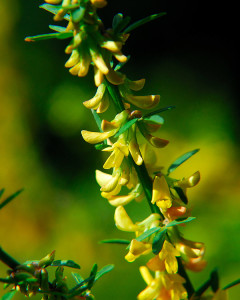
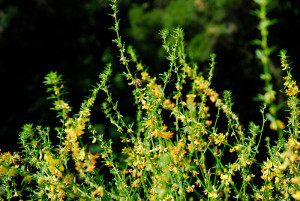
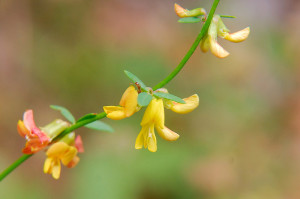
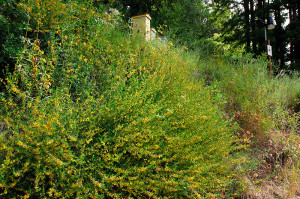
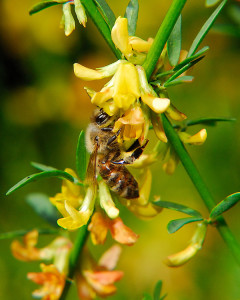
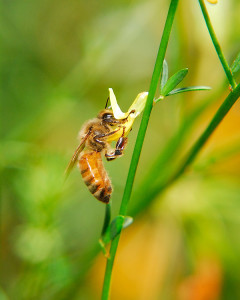

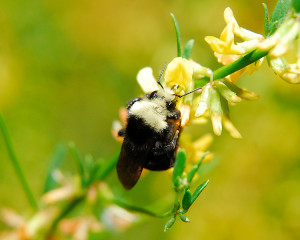

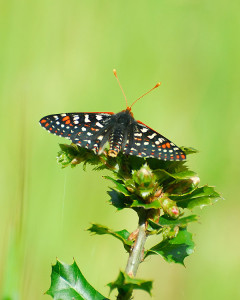
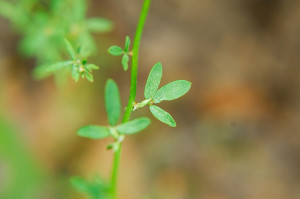

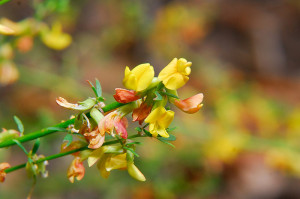







Interesting feature…the bees seem to really like the deerweed. I like the draping effect over the pathway. It has a nice fullness that works well for spilling over.
I didn’t think that much of it at first, but now these plants have filled in, I agree, it has a lovely fullness to it. I have discovered that when it spills into a pathway though, you have to be very careful not to step on bees!
Love that plant, and now I understand why it was so abundant this year down near Tassajara. Of course, it’s the fire! Good advice about the seeds, I’ll pass that along to the head gardener…
It would be interesting to see how that area changes over time, since the fire. I wonder how long it will take before the Deerweed makes way for the next succession of plants?
Wonderful native plant…so beautiful and loved by many
I hadn’t truly appreciated it as a habitat plant, until this year. I knew the bumbles liked it, but didn’t realize it was a valuable larval food resource for butterflies, or that our bees would go so bonkers for it! Now I’m really glad we have so much of it 😉
Wonder if a crab/flower spider lurks with the dead bumble?
That’s a good thought Diana. I’ve seen quite a few crab spiders in the garden this year, and even sighted my first brilliantly yellow one on a daffodil this spring. I didn’t see a crab spider associated with this Carpenter Bee, but it’s certainly possible that one was responsible for its demise. I found one last year snacking on a honey bee:
https://curbstonevalley.com/blog/?p=2128
Those spiders don’t seem to have any trouble attacking prey much larger than they are. If that’s the case maybe the bee was too heavy, and he dropped it 😉
Out of curiosity, what was your reference for which butterfly caterpillars feed on deerweed?
Clare, I love what you’ve done with your website. It looks great and is well organized. (Sorry, I’ve been meaning to tell you this for a while.)
It was a few different resources, but the primary one was Garth & Tilden’s California Butterflies. The checkerspot larvae is personal observation, and I’ve read some other ancedotal accounts of checkerspot larvae feeding on this species. I know it’s not a preferred source for the checkerspots, who usually stick to species in the Scrophulariaceae family. Admittedly, much of our Lotus scoparius here is tangled up with our Diplacus aurantiacus (which could be affecting food choice), but we have seen some damage on the deerweed from the larvae.
Clare, I love the legumes~There’s so many marvelous native plants to grace our gardens and feed our wildlife. Your bees look very happy. gail
Our bees do seem quite delighted, although I’m honestly not sure how much nectar these tiny flowers actually produce.
Clare, the deerweed seems to be a bee favorite. Your comment about not stepping on the bees puts it into perspective of how much.
I’ve been made aware of bees on the ground on the rare occasion I go to the garden in flip flops 😉
Great photos. I thought, poor little dead bee, but he must have died contented, resting amidst a favorite flower.
It was quite a large bee, and really stood out among the foliage and flowers. I could think of worse ways to go than eternal sleep amidst your favorite blooms 😉
I have meant to comment on this several times, but keep getting distracted by other interesting comments. =) Oops. Anyhow, GREAT timing. Was on training day out for a docent job and we saw L.s., and I said what it was tho’ wasn’t sure it was the same species as in San Diego. Now you’ve taught me TONS about the plant, and my docent trainer will LOVE all that info, from Native American uses to ecological roles and the “don’t bother, I’m pollinated = red” thing. SOOOO cool.
PERFECT timing. THANK YOU!!! =) Lovely little nitrogen fixer… I want some on my property, now!
There are a couple of subspecies. I think we have Lotus scoparius var. scoparius. San Diego though also also has the short-winged subspecies Lotus scoparius var. brevialatus, and I’m not sure which of those subspecies is more common down there. Regardless, it’s a lovely, and I think often overlooked plant. I think it’s quite an ingenious strategy to signal to the bees ‘move along…this flower is done’!
That’s great that the bees have a good food source close to home………. at least that will keep them from trying to attack you or Mr Curbstone.
How long do you expect these drifts to stay in flower for Clare?
Our bees have been much more calm recently, but their food stores in the hives are higher too. Last inspection we found a reasonable amount of capped honey. I have to assume they were grumpy before because stores got so low.
I don’t expect these blooms to last much longer. I’d be surprised if we’re seeing much in flower here by mid-August, but that’s rather typical of the native flora here in late summer. The ultimate adaptation to seasonal drought, is dormancy. When they’re stripped of their leaves in late summer, and just the woody stems remain, they somewhat remind me of tumble weeds in appearance.
Clare, I’m curious about the common name “deerweed.” Is this a deer favorite as well as a bee favorite? (I noticed you said it had gotten established between your two deer fences.)
Great post! I see this plant often but didn’t know its name, thank you for enlightening me. Wonderful pictures, too.
Glad to see you’re encouraging the natives. It can be hard sometimes to see the value in something that’s not obviously edible when we have edibles like tomatoes and squash on our minds.
We’ve been trying to promote milkweed, here, as well as some grasses that grow three feet tall and make a fine mulch (and cover for the chickens).
Deer brush, deer grass, and Buckbrush, we have all those but no deerweed so far. I had never heard of it. I love learning about and photographing new and known natives here, so I really like all your posts on the ones that grow there.
We each have endemic ceanothus, calochortus and lonicera, although they are all of different varieties. Pretty cool.